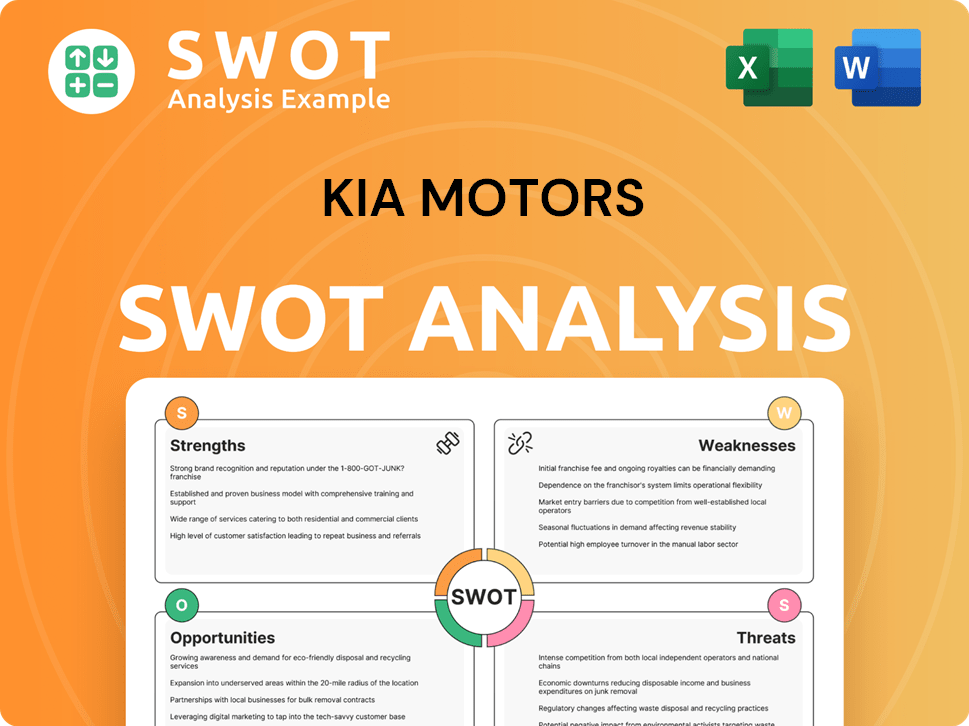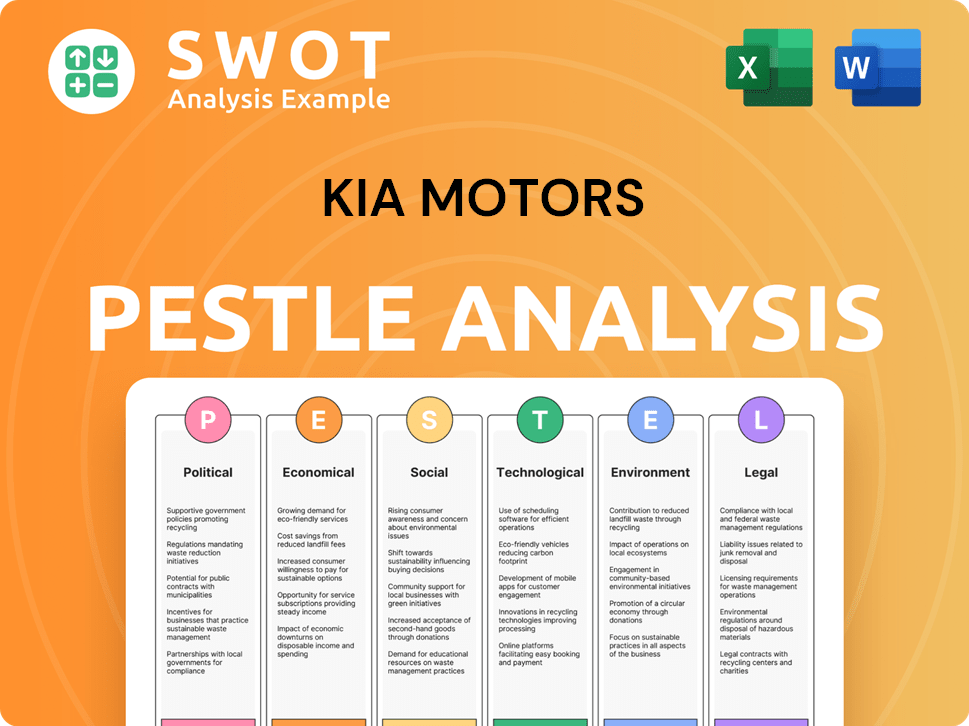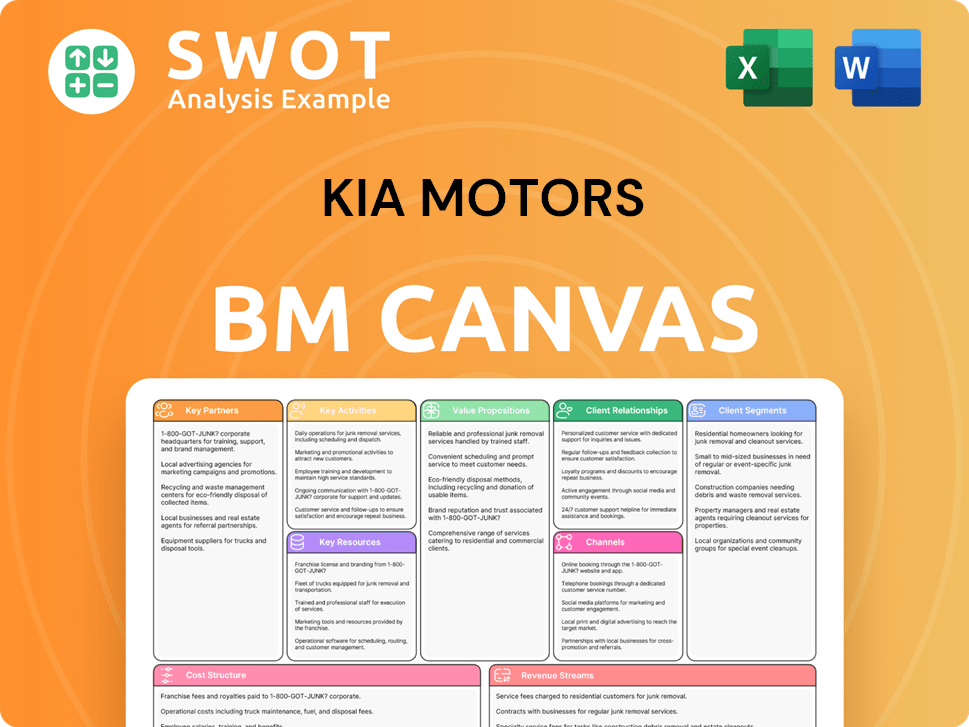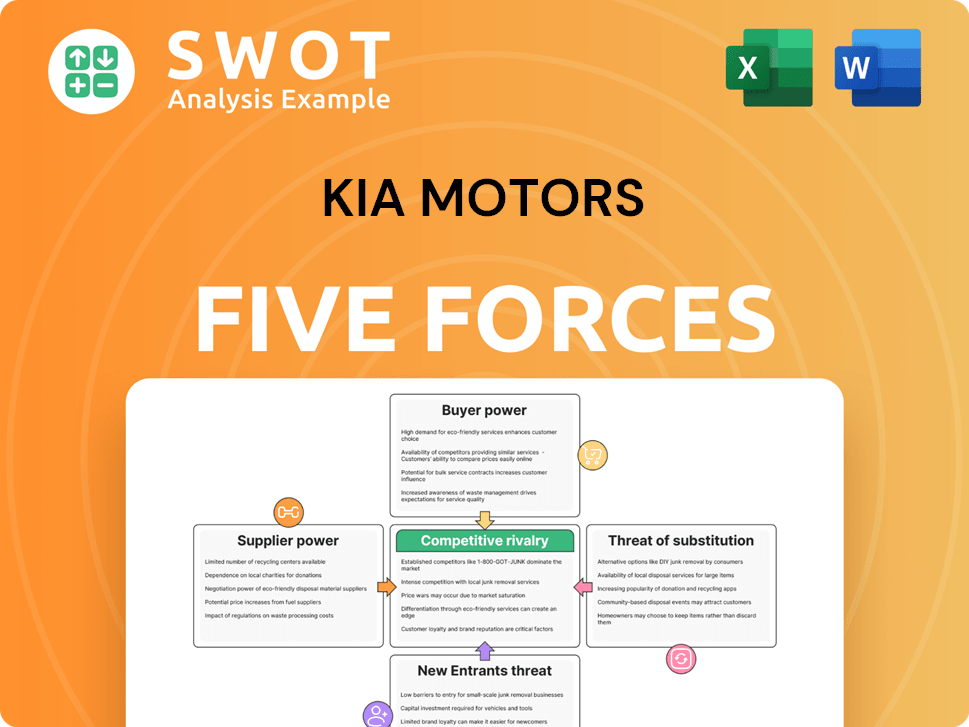Kia Motors Bundle
How Does Kia Motors Stack Up in Today's Auto Market?
The automotive industry is a battlefield of innovation and consumer demand, and Kia Corporation has emerged as a dynamic player. This analysis dives into the Kia Motors SWOT Analysis, exploring its evolution from a niche manufacturer to a global force. We'll dissect Kia's strategic moves, from its design-led approach to its ambitious electric vehicle (EV) initiatives.

This exploration of the Kia Motors Competitive Landscape provides a critical Kia Market Analysis, evaluating its position amidst Automotive Industry Trends. We'll identify key Kia Competitors and assess Kia's Strategy for sustained growth. Understanding Kia's competitive advantages is crucial for investors, strategists, and anyone interested in the Car Market Share dynamics.
Where Does Kia Motors’ Stand in the Current Market?
Kia Corporation has established itself as a significant player in the global automotive market, demonstrating substantial growth and strategic expansion across various segments and geographies. In late 2024 and early 2025, Kia, along with its affiliate Hyundai, collectively ranked as the world's third-largest automaker by sales volume in 2023, behind Toyota and Volkswagen, showcasing its strong market presence and penetration.
In 2023, Kia reported global sales of 3.085 million units, a 6.3% year-on-year increase, indicating consistent upward momentum. The company's product range includes popular SUVs like the Sportage and Sorento, passenger cars such as the Forte (Cerato) and K5 (Optima), and an expanding lineup of electric vehicles like the EV6 and EV9. Kia has made significant strides in the electric vehicle (EV) segment, with EV sales reaching 182,177 units in 2023, an increase of 15.3% year-on-year.
Kia's geographic presence is extensive, with strong footholds in North America, Europe, and its home market of South Korea, alongside growing influence in emerging markets. In the US, Kia achieved its highest-ever annual retail sales in 2023, selling 782,451 units, a 13% increase over the previous year. Kia has strategically shifted its positioning over time, moving towards a more premium brand image, particularly evident in its design language and advanced technology offerings.
Kia's market share has steadily grown, supported by strong sales figures. In 2023, Kia's global sales reached over 3 million units, reflecting its increasing popularity and competitive positioning. This growth is driven by successful models and strategic expansions.
Kia's diverse product portfolio, including SUVs, passenger cars, and EVs, caters to a wide range of consumer preferences. The EV6 and EV9 models highlight Kia's commitment to innovation and sustainable mobility. Kia's focus on design and technology enhances its brand appeal.
Kia has a strong presence in North America, Europe, and South Korea, with growing influence in emerging markets. The US market saw record sales in 2023, demonstrating successful market penetration. Kia continues to expand its reach globally.
Kia's financial health is robust, with strong operating and net profits in 2023. The company's strategic shift towards a premium brand image and focus on EV development support its long-term growth. Kia's financial strategies drive its market position.
Kia's financial performance remains strong, with a reported operating profit of 11.606 trillion won (approximately $8.5 billion USD) and a net profit of 8.778 trillion won (approximately $6.4 billion USD) in 2023, reflecting its robust profitability and operational efficiency. Kia's focus on strengthening its presence in regions like India and Southeast Asia highlights its strategic vision for future growth. For a deeper understanding of Kia's target market, consider exploring the Target Market of Kia Motors.
Kia's competitive advantages include a diverse product portfolio, strong brand image, and global presence. The company faces challenges such as intense competition in the automotive industry and the need to adapt to changing consumer preferences and technological advancements.
- Strong Brand Image: Kia has successfully enhanced its brand perception through design and technology.
- Global Presence: Kia's presence in key markets like North America and Europe supports its market share.
- Product Innovation: Kia's focus on EVs positions it well in the evolving automotive landscape.
- Market Competition: The automotive industry is highly competitive, requiring continuous innovation.
Kia Motors SWOT Analysis
- Complete SWOT Breakdown
- Fully Customizable
- Editable in Excel & Word
- Professional Formatting
- Investor-Ready Format

Who Are the Main Competitors Challenging Kia Motors?
The Kia Motors Competitive Landscape is shaped by a diverse array of global and emerging automotive manufacturers. The company faces both direct and indirect challenges in a market characterized by rapid technological advancements, shifting consumer preferences, and intense competition. Understanding the competitive dynamics is crucial for analyzing Kia's strategic positioning and future prospects.
Kia's strategy must account for the competitive pressures from established industry leaders and the disruptive forces of new entrants, particularly in the electric vehicle (EV) market. The company's ability to innovate, adapt, and effectively compete in various segments will determine its success. A thorough Kia Market Analysis reveals the complexity of these competitive interactions.
Kia's primary rival is Hyundai Motor Company, its affiliate. Both companies compete fiercely for market share, especially in SUVs and EVs. They often share platforms and technologies while differentiating through design and brand positioning. In 2024, Hyundai's global sales reached approximately 3.8 million vehicles, while Kia sold around 3.1 million vehicles, highlighting the close competition.
Toyota is a consistent market leader, challenging Kia with its reputation for reliability and extensive hybrid lineup. Toyota's global sales in 2024 were around 11.09 million vehicles. Toyota's hybrid technology and strong brand reputation are key competitive advantages.
Volkswagen Group competes across various price points and segments, particularly in Europe and China, and is expanding its EV portfolio. The Volkswagen Group's global sales in 2024 were approximately 8.3 million vehicles. The group's diverse brand portfolio, including VW, Audi, and Skoda, allows it to compete across a broad range of consumer segments.
General Motors is a strong contender in North America, especially in truck and SUV segments, and is heavily investing in EV development. GM's global sales in 2024 were around 6.2 million vehicles. GM's focus on the North American market and its investment in EVs are critical for its competitive position.
Ford is a major player in North America, particularly in the truck and SUV segments, and is also investing in EV development. Ford's global sales in 2024 were around 4.1 million vehicles. Ford's strong presence in the North American market and its strategic shift toward EVs are key.
Stellantis, formed from the merger of FCA and PSA, offers a diverse brand portfolio that competes with Kia in various regions and vehicle types. Stellantis' global sales in 2024 were approximately 6.1 million vehicles. Stellantis' diverse brand portfolio allows it to compete across various segments and regions.
Tesla, a pure-play EV manufacturer, remains a significant disruptor, challenging all traditional automakers with its advanced technology and charging infrastructure. Tesla delivered around 1.8 million vehicles in 2024. Tesla's technological leadership and direct-to-consumer model are key competitive advantages.
Beyond traditional automakers, Kia faces increasing competition from emerging players, particularly in the EV space. Chinese EV manufacturers like BYD, Nio, and Xpeng are rapidly expanding their global reach, offering compelling EV models with competitive pricing. BYD's sales in 2024 reached approximately 3.0 million vehicles, demonstrating their rapid growth. These new entrants often challenge established players through rapid innovation cycles and direct-to-consumer sales models. For more insights, consider reading a Brief History of Kia Motors.
The Kia Motors Competitive Landscape is shaped by several key factors that influence market share and profitability. These factors include:
- Pricing Strategy: Kia's ability to offer competitive prices, especially in the EV market, is crucial.
- Product Innovation: Rapidly introducing new models and technological advancements, particularly in EVs and autonomous driving, is essential.
- Brand Reputation: Building and maintaining a strong brand image for reliability, design, and customer satisfaction.
- Global Distribution: Expanding and optimizing its global distribution network to reach a wider customer base.
- Supply Chain Management: Effectively managing supply chain disruptions to ensure production and delivery.
Kia Motors PESTLE Analysis
- Covers All 6 PESTLE Categories
- No Research Needed – Save Hours of Work
- Built by Experts, Trusted by Consultants
- Instant Download, Ready to Use
- 100% Editable, Fully Customizable

What Gives Kia Motors a Competitive Edge Over Its Rivals?
The competitive landscape of Kia Motors is shaped by its distinctive design, aggressive electrification strategy, and synergy with Hyundai Motor Company. Kia has strategically positioned itself in the automotive industry by focusing on design innovation and technological advancements. Understanding the Revenue Streams & Business Model of Kia Motors is crucial for grasping its competitive advantages and future trajectory.
Kia's success is also driven by its commitment to electric vehicles (EVs) and its ability to leverage economies of scale through its affiliation with Hyundai. The company's focus on quality, reliability, and agile manufacturing further strengthens its position. These factors contribute to Kia's ability to compete effectively in a dynamic global market, adapting to changing consumer preferences and industry trends.
Kia's competitive edge lies in its ability to blend design, technology, and strategic partnerships. This approach has allowed it to capture market share and establish a strong brand presence. Kia's strategic moves in the EV market, combined with its focus on customer satisfaction and global expansion, are key to its sustained success in the automotive industry. The company's focus on innovation and adaptability allows it to stay ahead of the competition.
Kia's design philosophy, led by Karim Habib, has been crucial in attracting customers and elevating the brand's perception. The sleek K5 sedan and the futuristic EV9 SUV exemplify Kia's strong visual identity. This design-focused approach has helped Kia differentiate itself in the competitive car market.
Kia has invested heavily in electric vehicles, expanding its EV lineup with models like the EV6 and EV9. The E-GMP platform supports efficient production and fast charging. In 2023, Kia's EV sales increased by 15.3% year-on-year, demonstrating strong market acceptance.
Shared resources within the Hyundai Motor Group provide economies of scale and technological advantages. This collaboration allows Kia to access advanced technologies and manufacturing efficiencies, reducing costs and accelerating product development. This synergy is a key factor in Kia's competitive strategy.
Kia's focus on quality, backed by competitive warranties, builds customer trust and loyalty. Agile manufacturing processes and a global production network enable Kia to respond effectively to market demands. This focus on quality and efficiency supports Kia's competitive standing.
Kia's competitive advantages include distinctive design, a strong electrification strategy, and synergies with Hyundai. These factors contribute to Kia's ability to compete effectively in the automotive industry. Understanding these advantages is vital for a thorough Kia market analysis.
- Distinctive Design: Award-winning designs attract new customers and elevate brand perception.
- Electrification: Rapid expansion of EV lineup, including the EV6 and EV9, with a dedicated EV platform.
- Synergy with Hyundai: Shared resources and technology leverage reduce costs and accelerate product development.
- Quality and Reliability: Competitive warranties and high rankings in quality studies build customer trust.
- Agile Manufacturing: Flexible processes and a global network enable effective market response.
Kia Motors Business Model Canvas
- Complete 9-Block Business Model Canvas
- Effortlessly Communicate Your Business Strategy
- Investor-Ready BMC Format
- 100% Editable and Customizable
- Clear and Structured Layout

What Industry Trends Are Reshaping Kia Motors’s Competitive Landscape?
The automotive industry is currently undergoing a significant transformation, driven by electrification, autonomous driving, and digitalization, which presents both challenges and opportunities for companies like Kia. The shift to electric vehicles (EVs) is particularly prominent, necessitating substantial investments in infrastructure and battery technology. Simultaneously, the rise of software-defined vehicles and connected services demands innovation and adaptation in business models.
Future challenges include managing supply chain disruptions, geopolitical tensions, and rising raw material costs. However, opportunities abound in the growing demand for sustainable mobility, expansion into emerging markets, and the development of new revenue streams through connected car services. Kia's strategic investments and focus on innovation are critical for maintaining its competitive position and ensuring long-term resilience.
The automotive industry is experiencing a rapid transition towards electric vehicles (EVs), driven by environmental concerns and government regulations. Autonomous driving technology and software-defined vehicles are also gaining prominence, requiring significant investments in research and development. Connectivity and digitalization are reshaping consumer expectations, demanding seamless in-car experiences and integrated digital services.
Kia faces challenges such as managing supply chain disruptions, particularly for semiconductors, which have impacted global vehicle production. Geopolitical tensions and economic uncertainties in key markets could also affect sales and profitability. Increasing raw material and energy costs pose a threat to profit margins. Rapid technological change requires continuous innovation and faster time-to-market.
Growing demand for sustainable mobility solutions, especially in urban areas, creates a fertile ground for Kia's EV and purpose-built vehicle (PBV) strategies. Expansion into emerging markets, where vehicle ownership is still on the rise, offers substantial growth potential. Developing new revenue streams through connected car services and subscription models presents another avenue for growth.
Kia's strategy involves strategic investments in future technologies, optimizing production processes, and adapting to evolving consumer preferences. The company aims to strengthen its competitive position by focusing on innovation, design, and customer satisfaction. This approach is crucial for navigating the dynamic changes in the automotive industry and maintaining a strong market presence.
The Kia Motors competitive landscape is dynamic, with established automakers and new EV startups vying for market share. The company’s success depends on its ability to adapt to changing consumer demands and technological advancements. Analyzing the Kia Market Analysis reveals the importance of factors such as brand reputation, product innovation, and pricing strategies. The Kia Competitors include major players in the automotive sector, such as Hyundai, Toyota, and Tesla.
- Kia's global sales in 2023 reached approximately 3.08 million units, reflecting a 6.4% increase compared to 2022.
- The company has increased its EV sales, with the EV6 and Niro EV models contributing significantly to its growth.
- Kia is focusing on expanding its EV lineup and investing in charging infrastructure to meet growing demand.
- The company's commitment to design and innovation has helped it gain recognition and awards in the industry.
Kia Motors Porter's Five Forces Analysis
- Covers All 5 Competitive Forces in Detail
- Structured for Consultants, Students, and Founders
- 100% Editable in Microsoft Word & Excel
- Instant Digital Download – Use Immediately
- Compatible with Mac & PC – Fully Unlocked

Related Blogs
- What are Mission Vision & Core Values of Kia Motors Company?
- What is Growth Strategy and Future Prospects of Kia Motors Company?
- How Does Kia Motors Company Work?
- What is Sales and Marketing Strategy of Kia Motors Company?
- What is Brief History of Kia Motors Company?
- Who Owns Kia Motors Company?
- What is Customer Demographics and Target Market of Kia Motors Company?
Disclaimer
All information, articles, and product details provided on this website are for general informational and educational purposes only. We do not claim any ownership over, nor do we intend to infringe upon, any trademarks, copyrights, logos, brand names, or other intellectual property mentioned or depicted on this site. Such intellectual property remains the property of its respective owners, and any references here are made solely for identification or informational purposes, without implying any affiliation, endorsement, or partnership.
We make no representations or warranties, express or implied, regarding the accuracy, completeness, or suitability of any content or products presented. Nothing on this website should be construed as legal, tax, investment, financial, medical, or other professional advice. In addition, no part of this site—including articles or product references—constitutes a solicitation, recommendation, endorsement, advertisement, or offer to buy or sell any securities, franchises, or other financial instruments, particularly in jurisdictions where such activity would be unlawful.
All content is of a general nature and may not address the specific circumstances of any individual or entity. It is not a substitute for professional advice or services. Any actions you take based on the information provided here are strictly at your own risk. You accept full responsibility for any decisions or outcomes arising from your use of this website and agree to release us from any liability in connection with your use of, or reliance upon, the content or products found herein.